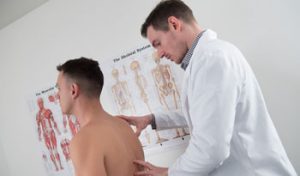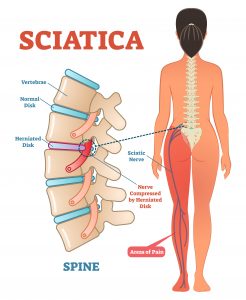Sacroiliac Joint Pain (Lower back pain)
Lower back pain is an epidemic, with 80% of people getting back pain at some point in their life. The severity and frequency of course changes depending on the type of lower back pain you are suffering from.
 Some back pain is more obvious than others – severe leg symptoms in young people with pins and needles worsening when you slouch is likely a slipped disc whereas pain developing after long periods sitting in a bad position is likely muscle pain.
Some back pain is more obvious than others – severe leg symptoms in young people with pins and needles worsening when you slouch is likely a slipped disc whereas pain developing after long periods sitting in a bad position is likely muscle pain.
Today we’re looking into the sacroiliac joint (SIJ), something that is consistently overlooked and brings a lot of confusion on those unsuspecting therapists. The confusion arises due to the fact that the SIJ only generates around 4˚, less than 1.6mm of movement, so a lot of therapists don’t believe it can become under dysfunction and cause pain. There are now many studies describing the SIJ as a possible pain source and can intimately describe the area of pain which can go down the leg and across the back.
Are you at risk?
So why do people get SIJ pain? As the SIJ transfers weight from the lower leg to the spine, a lot of the actions that cause it are related to load transferring. This is common in people that:
- Spend a lot of time standing on one leg (or leaning on one leg)
- Previously had lower back surgery
- Spend a lot of standing from stooped positions
- Have suffered a sudden jarring of the back
- Do a lot of lifting and twisting at the same time
- Over-zealous kick missing an object
- Have landed on buttocks
 There are other non-biomechanical reasons for SIJ pain. The main cause for concern would be if there are signs of rheumatoid arthritis (click on the link for more information). Risk factors for this include a family history of it, associated back stiffness and pain in the feet, ankle/toes/wrist/finger swelling on both sides and fatigue. If you have any concerns about this please do not hesitate to speak with us at the clinic.
There are other non-biomechanical reasons for SIJ pain. The main cause for concern would be if there are signs of rheumatoid arthritis (click on the link for more information). Risk factors for this include a family history of it, associated back stiffness and pain in the feet, ankle/toes/wrist/finger swelling on both sides and fatigue. If you have any concerns about this please do not hesitate to speak with us at the clinic.
Another reason for spontaneous SIJ pain is pregnancy or hypermobility. The reason for this is the laxity in the ligaments that support the joint.
Pregnant women are at risk of developing SIJ pain during and after pregnancy, as the ligaments get lax so the baby can pass through the canal easier. The hormone that does this is called relaxin and keeps the ligaments lax for around 3 to 4 months post pregnancy.
Hypermobility is a common issue often overlooked when trying to conclude a source for joint pain. An SIJ that is moving too much can become painful.
How do we fix it?
So, like any condition, the number one priority is figuring out the diagnosis and the severity. Once this has been done and we’ve excluded what we call systemic causes (reasons for the condition that we can’t help manage, such as rheumatoid arthritis and hypermobility – although we can certainly help hypermobile patients with their SIJ pain). The next step is the underline the mechanical cause, as lower back stiffness and hip stiffness can contribute. The answer in this case is easy – loosen up the lower back or hips.
If the cause is more of a general weakness then exercise prescription is a great way of dealing with the issue. There is a lot of research indicating strengthen the lower back muscles can help reduce the chances of SIJ pain. In clinic, I would suggest that reducing stiffness and strengthening together can be a very effective way of helping a patient with SIJ pain.
For any other questions, please contact the Clinic directly on:
0161 209 3980
info@movementandwellbeingclinic.co.uk
Ed Madeley M.Ost
